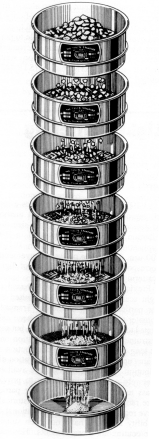Analyzing Sieves
Analyzing Sieve is a practice or procedure used to assess the particle size distribution (also called gradation)of a granular material.The size distribution is often of critical importance to the way the material performs in use. A sieve analysis can be performed on any type of non-organic or organic granular materials including sands, crushed rock, clays, granite, feldspars, coal, soil, a wide range of manufactured powders, grain and seeds, down to a minimum size depending on the exact method. Being such a simple technique of particle sizing, it is probably the most common.
Types of gradation
Dense gradation
A dense gradation refers to a sample that is approximately of equal amounts of various sizes of aggregate. By having a dense gradation, most of the air voids between the material are filled with particles. A dense gradation will result in an even curve on the gradation graph.
Narrow gradation
Also known as uniform gradation, a narrow gradation is a sample that has aggregate of approximately the same size. The curve on the gradation graph is very steep, and occupies a small range of the aggregate.
Gap gradation
A gap gradation refers to a sample with very little aggregate in the medium size range. This results in only coarse and fine aggregate. The curve is horizontal in the medium size range on the gradation graph.
Open gradation
An open gradation refers an aggregate sample with very little fine aggregate particles. This results in many air voids, because there are no fine particles to fill them. On the gradation graph, it appears as a curve that is horizontal in the small size range.
Rich gradation
A rich gradation refers to a sample of aggregate with a high proportion of particles of small sizes.
Limitations of sieve analysis
Sieve analysis has, in general, been used for decades to monitor material quality based on particle size. For coarse material, sizes that range down to #100 mesh (150μm), a sieve analysis and particle size distribution is accurate and consistent. However, for material that is finer than 100 mesh, dry sieving can be significantly less accurate. This is because the mechanical energy required to make particles pass through an opening and the surface attraction effects between the particles themselves and between particles and the screen increase as the particle size decreases. Wet sieve analysis can be utilized where the material analyzed is not affected by the liquid - except to disperse it. Suspending the particles in a suitable liquid transports fine material through the sieve much more efficiently than shaking the dry material. Sieve analysis assumes that all particle will be round (spherical) or nearly so and will pass through the square openings when the particle diameter is less than the size of the square opening in the screen. For elongated and flat particles a sieve analysis will not yield reliable mass-based results, as the particle size reported will assume that the particles are spherical, where in fact an elongated particle might pass through the screen end-on, but would be prevented from doing so if it presented itself side-on.
Properties
Gradation affects many properties of an aggregate. It affects bulk density, physical stability and permeability. With careful selection of the gradation, it is possible to achieve high bulk density, high physical stability, and low permeability. This is important because in pavement design, a workable, stable mix with resistance to water is important. With an open gradation, the bulk density is relatively low, due to the lack of fine particles, the physical stability is moderate, and the permeability is quite high. With a rich gradation, the bulk density will also be low, the physical stability is low, and the permeability is also low. The gradation can be affected to achieve the desired properties for the particular engineering application.
